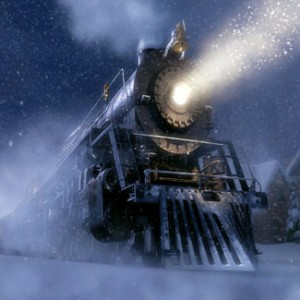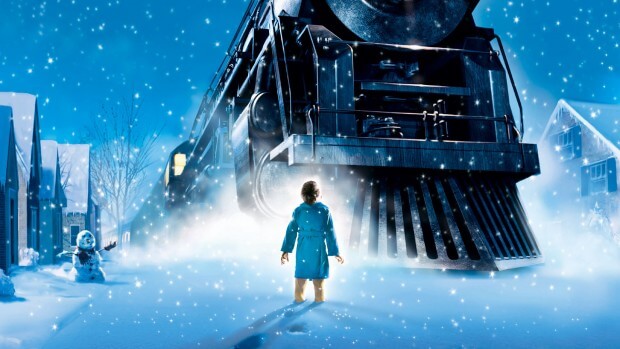Performance Capture CGI Technique In ‘The Polar Express’: An Advance For Animation
 In the world of high-roller feature film animation these days, you gotta’ have 3D CGI, and you gotta’ have a ground-breaking new animation or film-making technique. So when Warner Bros. spent a reported $170 million to produce ‘The Polar Express’, in theaters November 10, and another $125 million for global marketing and distribution, director Robert Zemeckis employed a new way to insert actors like Tom Hanks into the CGI environment, called Performance Capture. Which, if not of particular interest to the average family looking for a holiday film experience, was sure to impress nervous studio executives anxious for the film to be an ‘event’.
In the world of high-roller feature film animation these days, you gotta’ have 3D CGI, and you gotta’ have a ground-breaking new animation or film-making technique. So when Warner Bros. spent a reported $170 million to produce ‘The Polar Express’, in theaters November 10, and another $125 million for global marketing and distribution, director Robert Zemeckis employed a new way to insert actors like Tom Hanks into the CGI environment, called Performance Capture. Which, if not of particular interest to the average family looking for a holiday film experience, was sure to impress nervous studio executives anxious for the film to be an ‘event’.
Based on the popular 29-page children’s book by Chris Van Allsburg, ‘The Polar Express’ represents yet another mile-marker in the technology of film-making for Zemeckis, whose successful ‘Back To The Future’ (1985) films were ahead of the pack for effects about 20 years ago. Working with a team of hundreds of visual effects artists at Sony Imageworks, Zemeckis and multiple Academy Award-winning effects wizard Ken Ralston proposed to create the magical and visually stunning animation style they wanted for ‘Express’ performances with ‘motion capture’. Mo-cap is a process by which an actor’s live performance is digitally captured by computerized cameras, and becomes a human blueprint for creating virtual characters.
By the time they moved into production, Imageworks visual effects supervisor Jerome Chen’s preliminary work on the advanced mo-cap process that would be called Performance Capture, was ready to test, and then put to work making ‘Express’. But Zemeckis and Hanks (who has a producer credit on the film aside from acting chores), also wanted ‘Express’ to preserve the look and feel of the original illustrations in Allsburg’s book, noted for their warmth and realism.
“Chris’s illustrations are honest and familiar and at the same time wonderfully transcendent,” says Zemeckis in the Warner Bros. production notes (polarexpressmovie.warnerbros.com).
“It’s easy to see yourself, your children, or the kids you grew up with in the faces and personalities of these characters, and the landscape that the train passes through is like the dreams we all had about distant places where magical and exciting things could happen,” he adds.
Hanks said he and Zemeckis agreed it would be a good idea “to recreate each painting in the book at some point throughout the movie. We might create an elegant film that would present the Christmas spirit in a brand new way.”
Aside from creating a compelling CGI film that would be true to Allsburg’s original illustrations, Zemeckis insisted that ‘Express’ would feature virtual characters whose appearance and performances were at the next-generation level. Chen’s work with Ralston, and the Performance Capture process they developed, satisfied Zemeckis that first-rate talent like Hanks, the late Michael Jeter, Charles Fleischer and others, could be translated to the virtual world of the film with the highest level of fidelity to their acting talent.
The Performance Capture system was designed to digitally collect every discernable movement and subtle human expression, down to Hank’s or other actor’s smile, wink or walk. Unlike existing mo-cap, Performance Capture can simultaneously record 3-dimensional facial and body movements from multiple actors, using a system of digital cameras that provide 360 degree views.
“If this hadn’t been possible, or hadn’t evolved to this degree, I likely would not have moved forward with the project,” Zemeckis says in Warner’s production notes.
With this system, the director could literally create custom shots during the editing process, selecting from a range of depths and perspectives, and moving characters in their cyber-world to emphasize specific details, with natural camera moves.
One big difference noted by the director, was that actors were not in costume or surrounded by elaborate ‘real’ sets from the film’s world, as performances were digitally captured. Instead, they would wear a special mo-cap suit equipped with sensors. It took nearly two hours to apply as many as 150 reflective ‘jewels’ that were clustered on the actors’ faces and scalps, adhering to all lines of musculature, eyelids, brows, upper and lower lips, chin line and cheeks. Once they were wired up, actors delivered their performances as if on stage.
“I believe the only thing Tom missed was having the physical trappings of a costume,” the director said. “He had to remember that the conductor wore glasses when he was the conductor and he had to remember to touch the bill of his cap or adjust his collar, which he would have done more instinctively if he had been actually wearing that wardrobe.”
“As actors, we were able to imprint our performances onto the story as opposed to going into the recording studio and providing voices. It was fun but it was also incredibly challenging. Because of the sensors, everything you do registers so you cannot afford to make a mistake,” said Hanks.
Zemeckis adds that by using this technique, the acting and expressions of the virtual characters that appear in the film, are all provided by real, human actors like Hanks and Jeter. “No one animates that,” said Zemeckis. “The computer does not create the performance, the actors do. The computer just takes the performance and wraps a cinematic skin around it.”
Hanks has numerous roles, including protagonist Hero Boy, and Hero Boy’s Father, the Conductor on the train that is the Polar Express, a Hobo on the train, and Santa Claus. Michael Jeter plays an unlikely pair of twins, engineer Steamer and fireman Smokey (one tall and thin and the other short and round). Jeter, a well-known character actor, passed away shortly after completing his work on the picture. “It was terribly tragic and unexpected,” Zemeckis said. Production was suspended on the news of Jeter’s death, and ‘The Polar Express’ was his final performance.
Other performers include Peter Solari as Lonely Boy, Nona Gaye as Hero Girl, Eddie Deezen as Know-It-All Boy, and Charles Fleischer as the Elf General. One unusual casting choice was that of Aerosmith rocker Steve Tyler as an elf. Tyler was brought in to perform Glen Ballard’s original tune “Rockin’ On Top of the World” in a scene where all the elves cut loose with a wild party as Santa departs. Zemeckis intuitively sensed that Tyler would make a great elf. The rocker signed on to wear a mo-cap suit and soon found himself digitized into the film.
The Los Angeles Times reports on Oct. 22 that Warner Bros. is taking a big financial risk with the film. With real estate multi-millionaire, financier and producer Steve Bing venturing $85 million of his personal fortune on the project, executives fear that ‘Express’ might be de-railed by the release of yet another of Pixar’s CGI powerhouse films (‘The Incredibles’) five days before ‘Express’ opens, and the opening of ‘The Sponge Bob Square Pants Movie’ from Paramount on Nov. 19. A ball-park estimate of $500 million represents what ‘Express’ would have to make worldwide in all formats to become profitable for all involved, the Times said. Hanks and Zemeckis are promised a big stake (one-third) of profits.
All the more reason, then, why the Performance Capture process needs to perform. Although mo-cap has been around a while, the significant advances of the new technique used here give ‘Express’ an immediate cache of artistic credibility and a ‘must-see’ factor for legions of animation lovers around the globe. The story and property involved are also well-known, with a wonderful life-lesson for kids and adults set in a snowy wonderland full of fantastic characters and events.
Zemeckis, no slouch in the quality-control department, was ultimately pleased with Performance Capture. “It raises your level of work as a director,” he said, “in that it allows you to do anything. The only limit now is the film-maker’s imagination, because you can literally create any image. I can do a spectacular shot with a little kid on top of a roaring train in the snow at night, and I don’t have to worry about how I’m going to do it. I don’t have to worry about the kid falling off the train, or the camera frosting over or whether the train will hit its mark. I now have complete control over those elements. It’s the closest thing we have to typing a story into a computer and having a film come out the other side.”
As fans of Zemeckis’ work may recall. the director did extensive live-action labor with a real locomotive in his film ‘Back To The Future Part III’ (1990), with actors Michael J. Fox and Christopher Lloyd jumping around on the back of a hurtling steam locomotive in the climactic sequence. Once again, the majestic figure of the ‘Iron Horse’ that once ruled the rails looms large in Zemeckis’ career. But now, things have changed in terms of creating those spectacular elements.
“The traditional hundred-year-old optic, chemical, mechanical way in which we recorded movie images is changing,” he says in Warner Bros. production notes. “When people see ‘The Polar Express’ in a digital theater, there’s no film. There was no film involved at any stage.”
For the animation community, Performance Capture is yet another tool that expands the film-maker’s ability to create un-ending fantasy worlds, bigger and better action sequences, and now, virtual characters performed by well-known acting talent and realized in CGI with great attention to the ‘human’ side of theatrical pretense. Films like ‘Final Fantasy: The Spirits Within’ (2001) also made extensive use of virtual characters, with varying degrees of success. That film, four years in production, featured stunning CGI visuals, but characters may have seemed somewhat wooden, un-realistic, or flat, despite great effort to avoid exactly that short-coming. Similarly, even the skilled and high-paid animators at Pixar, when rendering human characters in a film like ‘Toy Story’, were notably at a loss as to how to bring a CGI rendering of a human being in a key role to life with energy, life-like features, and convincing movements and appeal. With Performance Capture, and its debut now in ‘The Polar Express’, it will be seen whether or not this is finally overcome. Rumors years ago that ‘digital actors’ would soon replace even the most well-known human movie stars may never become reality. But with this technique, popular and talented performers who are a marquee draw to the box office anyway, can now step into imaginary CGI realms, with all their acting chops in-tact. This has consequences not just for actors, but for film-makers, studios, audiences, writers, and of course, animators. So if you want to ride that train, it leaves the station at a theater near you on Nov. 10 when ‘The Polar Express’ opens (US). All aboard!
Items mentioned in this article:
![The Polar Express [DVD]](https://www.skwigly.co.uk/wp-content/themes/skwigly-2024/images/amazon-image-default.png)


